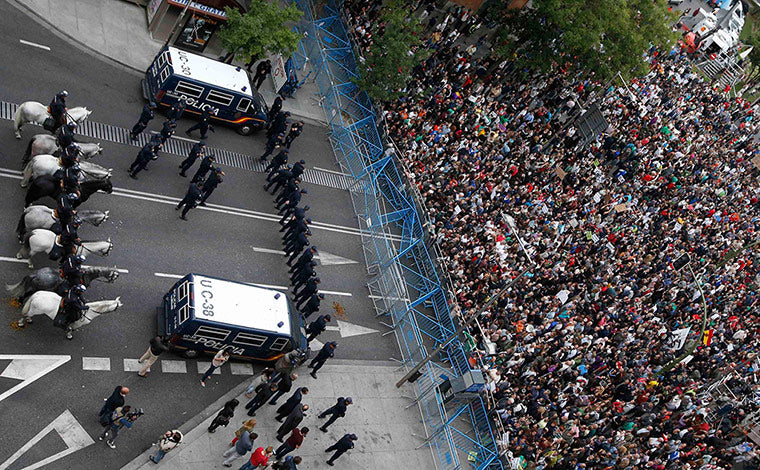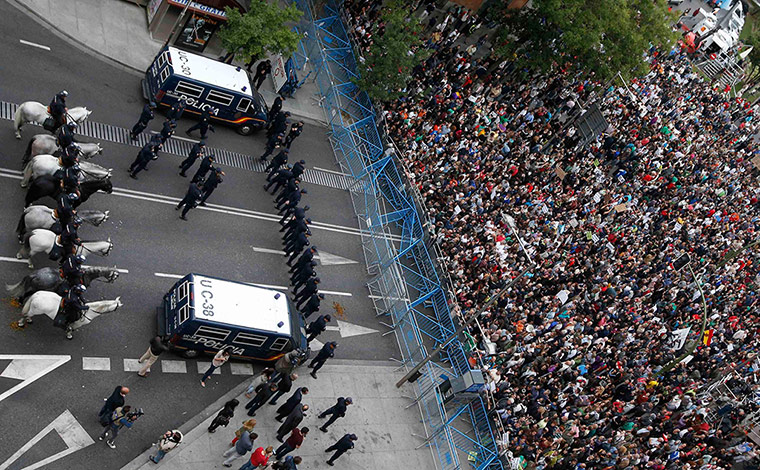No Future is the only Future: #S25, Anti-Austerity, and the Greek General Strike


According to the BBC, Madrid is expected to propose £39bn ($50bn; £31bn) worth of public sector cuts, tax raises and structural liberalizations. Most demonstrators, indeed I imagine, most people in Spain, believe that the new austerity measures are economically suicidal for the people. As Costas Lapavitsas point out in Crisis in the Eurozone, Spanish unemployment “has risen faster than in other countries once the crisis of 2007-9 materialised.” It “seems to expland rapidly in Spain at the first sign of economic difficulty” (p.14). El Pais reports that according to a study by the Association of Temporary Employment Agencies [AGETT], the number of long-term unemployed has quadrupled since the crisis began five years ago, topping 5.69 million in June 2012. Furthermore, the rate of joblessnes at the end of June was 24.6%, making it "the highest in the European Union and more than double the average in the EU." And it's no surprise that the majority of the demonstraters were youths as the rate for workers under 25 is over 50%.
The state’s future depends on either more extreme austerity measures or a European bailout and more international debt. They are aiming for the former, but might have to take the latter. Both carry the risk of eventual default and devaluation, which as Lapavitsas explains, definitely carries costs, but might actually be the better option for countries that face a debt crisis largely caused by international finance:
The #S25 anti-austerity demonstration is just one articulation of a broader, more intense, and increasingly desperate social struggle that resists the old forms—of positivistic progress, of teleological Marxism, of social democracy, etc. There are demonstrations. There are occupations. There are general strikes [Greece yesterday]. There are riots. [#S25]The costs can be reduced and a path can be cleared for future economic growth, if governments are prepared to act decisively, breaking the international consensus if needed.
At the same time, default and devaluation, particularly when they involve a change of monetary standard, as in Argentina, also entail wealth transfers and a rebalancing of class forces. They could re-strengthen the rule of the domestic capitalist class, but they could also create opportunities to shift the balance of power in favour of labour. They could open the way for public ownership and control over banks, regulation of capital flows, public control over other areas of the economy, industrial policy, and redistribution of income and wealth. The eventual outcome of default and devaluation, in other words, depends on social struggle. This is the challenge that is currently confronting working people in the periphery of the eurozone. (p.145-6)
La Policía carga contra manifestantes del 25SVer vídeo

And there are revolutions. The problem today is that all notions of what ‘the future’ might lead to have been thoroughly recuperated or betrayed. “There is no future” the seemingly nihilistic line made famous by John Lydon back in the crisis of the late 1970’s has now been generalized. In terms of capital, debt, and the state’s austerity measure to try to save itself (not mind you, the public): “There is no future for you. There is no future for me.”
What all the people subject to the capitalist state’s austerity measures have in common is that they have been pushed outside the system. Their stake in it has been liquidated, and thus with this radicalization of the situation, a real antagonism develops. As Slavoj Zizek points out in his new book The Year Of Dreaming Dangerously:
a conflict between non-society and society, between those who have nothing to lose and those who have everything to lose, between those without a stake in their community and those whose stakes are the greatest. (p. 60)
And rather than ‘revolutionary networks’ we have ‘networked revolutions.’ As Paul Mason is keen to point out in Why It’s Kicking off Everywhere the present moment is “something wider than a pure political overthrow and narrower than the classic social revolutions of the twentieth century” (p. 80). He quotes a prophetic André Gorz on the nature of this new antagonism:
Taking power implies taking it away from its holders, not by occupy- ing their posts but by making it permanently impossible for them to keep their machinery of domination running. Revolution is first and foremost the irreversible destruction of this machinery.

When the demonstrators proclaim “there is no future,” it is not out of nihilism. It is rather the purest expression of desire for ‘the real movement to abolish the present state of things.’ The social struggle announces ‘no future’ precisely because it recognizes that ‘the future’ is not its own under the capitalist state. The future is a future present, a continuation toward the full realization of contemporary trends. There is no ‘future that works’ because ‘work isn’t working,’ democracy isn’t working,’ and capitalism, frankly, has never really ‘worked.’ Zizek, channeling T. J. Clark, notes that it exactly the ‘futuralism’ of the Left that accounts for its inability to act:
in its orientation towards a future of radical emancipation; due to this fixation, the Left is immobilized “by the idea that it should spend its time turning over the entrails of the present for the signs of catastrophe and salvation,” that is, it continues to be premised “on some terracotta multitude waiting to march out of the emperor’s tomb.”
And adopting the position of a late Jaques Derrida Zizek further explains that “no future” is:
at a deeper level, it does not designate the closure, the impossibility of change, but what we should be striving for—to break the hold of the catastrophic “future” and thereby open up a space for something New “to come.” (p. 134)